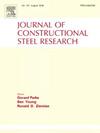Mechanical behavior of structural steel clad by wire arc thermal spraying
IF 4
2区 工程技术
Q1 CONSTRUCTION & BUILDING TECHNOLOGY
引用次数: 0
Abstract
Thermal spraying is a surface modification technique in which molten particles are deposited to form protective or functional coatings. This study investigated the mechanical behavior of structural steel components strengthened by wire arc thermal spray cladding. The thermal spraying process was performed using martensitic stainless steel wire to achieve a target cladding thickness of approximately 5 mm. Tensile, compression, and bending tests were conducted to evaluate the mechanical performance of the cladding under various loading conditions. The cladding exhibited a Young's modulus of 70 GPa, approximately one-third that of bulk steel. The tensile strength of the cladding was estimated at 231 MPa, with brittle fracture occurring at a strain of 0.3 %. Despite its limited tensile ductility, the cladding contributed to an increase in axial stiffness in the elastic range. In contrast, under compression, the cladding exhibited ductile nonlinear behavior and failed by vertical cracking. The 0.2 % proof stress of the cladding in compression was 1.3 times that of the substrate, indicating adequate load-bearing capacity under compressive stress. In bending tests, the maximum load of clad steel plates was five times that of unclad steel plates, although cracking and debonding of the cladding were observed. These findings suggest that cladding applied by thermal spraying has mechanical characteristics suitable for structural applications, particularly under compressive stress.
电弧热喷涂覆层结构钢的力学性能
热喷涂是一种表面改性技术,其中熔融颗粒沉积形成保护性或功能性涂层。研究了电弧热喷涂覆层强化钢结构件的力学性能。采用马氏体不锈钢丝进行热喷涂工艺,以达到约5mm的目标包层厚度。进行了拉伸、压缩和弯曲试验,以评估包层在各种载荷条件下的力学性能。包层的杨氏模量为70 GPa,约为体钢的三分之一。熔覆层的抗拉强度为231 MPa,应变为0.3%时发生脆性断裂。尽管其有限的拉伸延展性,包层有助于增加轴向刚度在弹性范围内。而在压缩作用下,包层表现出延性的非线性行为,并发生垂直开裂破坏。包层压缩时的0.2%抗压应力是基体的1.3倍,表明在压缩应力下具有足够的承载能力。在弯曲试验中,虽然观察到包层开裂和脱粘现象,但包层钢板的最大载荷是未包层钢板的5倍。这些发现表明,热喷涂覆层具有适合结构应用的机械特性,特别是在压应力下。
本文章由计算机程序翻译,如有差异,请以英文原文为准。
求助全文
约1分钟内获得全文
求助全文
来源期刊

Journal of Constructional Steel Research
工程技术-工程:土木
CiteScore
7.90
自引率
19.50%
发文量
550
审稿时长
46 days
期刊介绍:
The Journal of Constructional Steel Research provides an international forum for the presentation and discussion of the latest developments in structural steel research and their applications. It is aimed not only at researchers but also at those likely to be most affected by research results, i.e. designers and fabricators. Original papers of a high standard dealing with all aspects of steel research including theoretical and experimental research on elements, assemblages, connection and material properties are considered for publication.
 求助内容:
求助内容: 应助结果提醒方式:
应助结果提醒方式:


